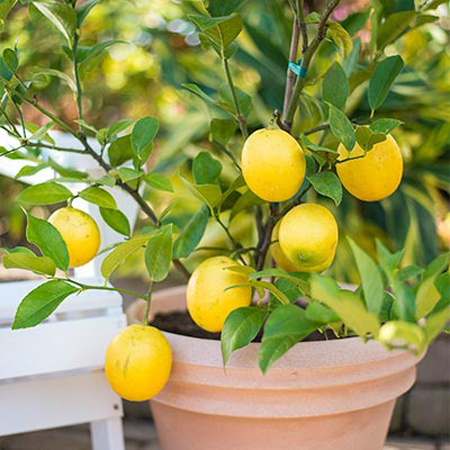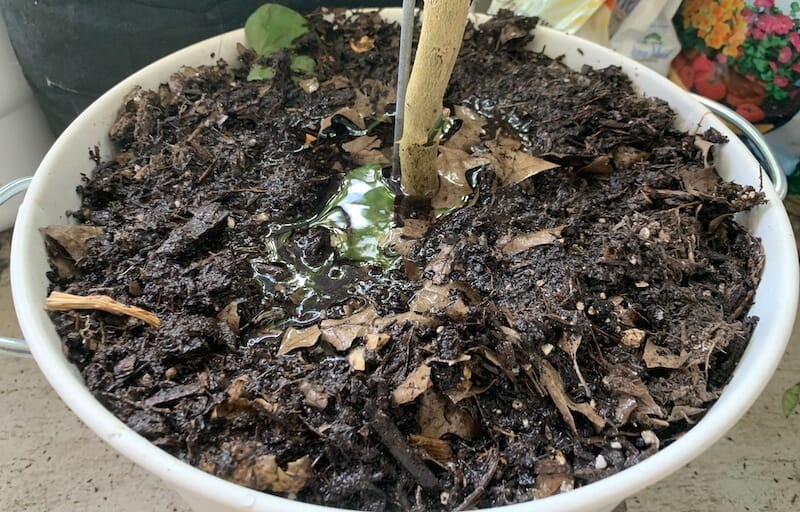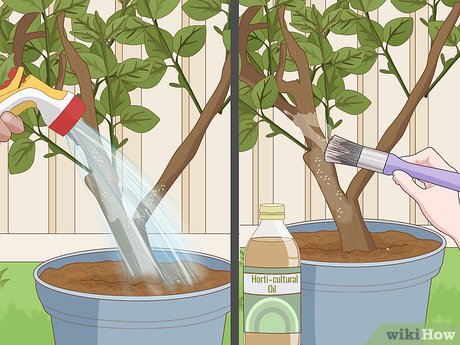
Lemon trees are sensitive to over watering, so water your lemon tree only when the top two inches of the soil have dried out and then soak your lemon tree with a generous amount of water. Lemon trees require more water in the Summer and should be watered less often in the Winter to avoid root rot.
In order to prevent root rot, which is brought on by overwatering and poorly draining soils, it is crucial to water lemon trees properly.
Lemon trees demand more water in the Summer as they prefer full sun and they are actively growing and much less water in the Winter as they are in a state of dormancy
Continue reading to find out how to water lemon trees in gardens and pots so they get the water they need and don’t get root rot.
Table of Contents
How Often to Water Lemon Trees
Lemon trees are tropical plants and thrive in Mediterranean environments with full sun and lots of heat but their roots should not be sat in consistently moist soil as this causes water stress and promote the conditions for the fungal disease root rot.
It is critical that the soil around your lemon tree dries out somewhat between bouts of watering as this replicates the natural watering cycle in their native environment.
Lemon trees should be watered when the top two inches of the soil feel dry to the touch.
How often to water lemon trees in your climate can be easily established by testing the soil to a fingers depth.
If the soil seems damp then avoid watering for a few days but if the soil feels as like it is drying up, then is the perfect time for watering.
How often you should water therefore varies according to your climate and conditions.
The following variables may influence how frequently you should water lemon trees:
- Heat and humidity (humidity slows water loss from the leaves and slow evaporation from the soil) (humidity reduces water loss from the leaves and slow evaporation from the soil)
- hours of sunlight (Lemon trees prefer full sun).
- The size of the pot in which it is planted (Smaller pots can dry out much quicker) (Smaller pots can dry out much quicker).
- The amount of airflow (Windy areas sap moisture from the leaves quicker) (Windy areas sap moisture from the leaves quicker).
- The capacity of the soil to retain moisture. (Lemon trees require good drainage to prevent root rot).
- The time of year for your tree (Watering frequency varies dramatically from Summer to Winter) (Watering frequency varies significantly from Summer to Winter).
To satisfy the water needs of the tree without overwatering and encouraging root rot, it’s vital to alter how frequently you water your lemon tree. Every climate, garden, and home has distinct conditions.
As long as the top two inches of the soil feel dry to the touch before watering, then you should escape any difficulties.
How to Tell if you are Watering too Infrequently (Symptoms of Over Watered Lemon Trees) (Symptoms of Over Watered Lemon Trees)
The first indication of a lemon tree suffer from drought stress is when the leaves of your tree begin to curl with an overall drooping appearance.
Lemon trees with curled leaves revive quite rapidly as long as you water them with a generous soak and return to a healthier appearance after roughly 2 cycles of watering.
Lemon trees with severe drought stress can cause the leaves to turn brown and the leaves to drop off. Lemon trees drop their leaves as a survival tactic to reduce further water loss from foliage.
It should be noted that if your lemon tree is losing leaves, this could be a sign of more serious issues than simply dry stress.
(Read my article on lemon trees dropping leaves to learn why its happening and how to solve the problem).
How to Tell if you are Watering Lemon Trees too Much…
The easiest way to tell your lemon tree is over watered is by feeling the soil. If the soil is consistently moist and does not dry out after week or so then the lemon tree shows signs of stress such as the leaves turning yellow and drooping.
In which case you should scale back the watering immediately and wait for the soil to dry out.
It should be noted that lemon trees leaves also turn yellow in reaction to cold temperatures or nutrient deficiencies.
(Read my article why are my lemon tree leaves turning yellow for how to save it).
How Often to Water Lemon Trees in Pots
All lemon trees should wait until the top 2 inches of soil feel a little dry to the touch before being watered.
However it should be noted that lemon trees in pots do need to be watered more often then lemon trees in garden soil.
Given the wide range of factors, it is impossible to provide general guidance on how often to water lemon trees in pots, but generally speaking, potted lemon trees should receive a good soak once a week.
Potted lemon trees should be watered more often because:
- If the pot is relatively small then there is less capacity for soil and therefore the soil retains less moisture and dries out quicker. So in the Summer months pots may require watering once every 3/4 days.
- Potted plants often have greater airflow around the leaves due to being raised higher then ground level which can sap moisture from the leaves.
- Some lemon trees are carried indoors for Winter protection. The temperature might change with interior heating and the air in our homes is frequently much dryer than the outside air, which increases soil evaporation and raises the need for water.
Consider these elements and take them into account while watering your lemon tree.
However it must re-emphasize the only method to set a dependable watering schedule is to monitor the soil moisture yourself to a depth of 2 inches.
This helps you avoid stress to your lemon tree from over or under watering.
How Often to Water Lemon Trees in Summer
When the lemon tree is actively growing and creating fruit in the summer, the requirement for moisture can significantly rise, so plan to water your tree more frequently.
- Potted lemon trees that are in blazing sunshine and enduring high temperatures should be watered as frequently as once every 2 days.
- Lemon trees in garden soil are more resistant to drought and can last up to a week without watering in Summer as long as they are watered with a generous soak and planted in soil with lots of organic matter to retain moisture.
Adjust your water scheduled accordingly if you have particularly fast or slow draining soils or perhaps more wind which and sap away moisture from the leaves.
You can avoid any issues caused by overwatering or underwatering as long as the top two inches of the soil are somewhat dry rather than damp before watering.
Remember that during times of dryness, leaves may occasionally curl as a defense against extremely high temperatures.
As long as you tree is watered adequately the leaves should recover in the lower temperatures of the evening.
How Often to Water lemon Trees in Winter
Lemon trees are most susceptible to the affects over watering in the Winter months as they are in a state of dormancy and require much less water.
In order to prevent the soil from drying out completely, lemon trees in pots should typically be watered once a month.
Lemon trees in garden soil can attain all their moisture requirements from the environment in Winter if they are a mature plant and it is unlikely they need watering until the following Spring.
It is important to note that lemon trees that are taken indoors can require more water if they are located near sources of heat or in the air current of any air con or forced air which saps moisture from the leaves.
Keep a close eye on your indoor lemon tree and look for any signs of stress due to under watering (leaves curling and dropping off) or signs of too much moisture (leaves turning yellow) and adjust your watering frequency accordingly.
How Much to Water Lemon Trees

Your lemon tree’s roots will grow as a result of a generous soak, making it more drought-resistant and able to access the nutrients it needs.
If you water too lightly such that only the first inch or so is moist then the water does not enter the soil efficiently and reach the roots where it is required and you lemon tree shows indicators of drought stress such as the leaves drooping.
(Read my article for tips on how to save your lemon tree if it is losing leaves.)
Well Draining Soil Mitigates Over Watering
Lemon trees should be planted in soil that is rich in organic matter, such as compost or leaf mold, because organic matter has the ability to hold moisture near the roots while also having excellent drainage properties that let excess water drain away.
This provides the perfect moisture balance for lemon trees to receive the moisture they need to develop healthy and also avoiding water accumulating around the roots which causes root rot.
If you lemon tree is in clay soil or compact soil then there is greater risk of root rot and you should water less frequently, and ideally transplant it to an area of the garden with well draining soil or amend the soil by adding lots of compost and some horticultural grit to improve drainage.
If your garden soil is waterlogged then it is recommended to grow lemon tree in pots as pots have more favorable drainage and it is possible to construct the optimal, well draining soil profile for lemon trees by planting then in compost mixed with some grit in pots.
Plant Lemon Trees in Pots with Drainage Holes in the Base

Watering your potted lemon tree so that water trickles out the base is also the best way to ensure that you have used a generous enough amount of water.
If lemon trees are in pots without drainage holes in the base then water pools around the roots and causes root rot, which turns the leaves yellow and causes it to die back.
Water can still collect around the roots of your lemon tree and cause problems if:
- Roots or compacted soil can block the drainage holes. If you see water draining from the soil slowly, then check to the hole in the base of the pot and clean anything that is slowing down the rate of drainage.
- the placement of trays and saucers beneath the lemon tree pots. Trays are often placed underneath the pots of lemon trees to avoid water flowing indoors. If the tray collects the excess water from watering then the soil remains too damp which can cause root rot.
- The earth underneath the pot is wet. In order to allow water to easily drain from the pot and avoid getting caught on a patio underneath the pot, it can be helpful to raise your potted lemon tree onto “feet” when you are outside.
(Read my article, how to resuscitate a dying lemon tree).
Key Takeaways:
- Lemon trees need to be watered when the top two inches of soil are dry to the touch, followed by liberal root irrigation. Lemon trees should be watered less often in Winter as they are dormant and watered more often in Summer when they are actively growing.
- Typically lemon trees should be watered once a week in pots in the Summer and watered once a month in Winter although watering frequency varies according to climate, weather and whether the plant is brought indoors for protection from frost in Winter.
- Plant lemon trees in well draining soil that contains a lot of organic matter or compost. Add some grit to improve drainage and prevent root rot in Winter.
- Lemon trees should be grown in containers with drainage holes in the bottom so that any excess water can drain away rather than collecting around the roots. Empty the saucers and trays regularly so that the soil does not stay soggy, to maintain the lemon tree healthy.
